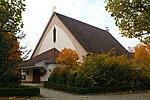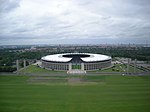Tennis Courts (Berlin)
Berlin building and structure stubsGerman sports venue stubsOlympic basketball venuesOlympic fencing venuesSports venues in Berlin ... and 3 more
Summer Olympic venue stubsTennis venues in GermanyVenues of the 1936 Summer Olympics
The Tennis Courts are courts located at Olympiapark Berlin in Berlin, Germany. Located southwest of the Olympic Stadium, they hosted the basketball and the Épée fencing event for the 1936 Summer Olympics.
Excerpt from the Wikipedia article Tennis Courts (Berlin) (License: CC BY-SA 3.0, Authors).Tennis Courts (Berlin)
Rossitter Platz, Berlin Westend
Geographical coordinates (GPS) Address Nearby Places Show on map
Geographical coordinates (GPS)
| Latitude | Longitude |
|---|---|
| N 52.517222222222 ° | E 13.249444444444 ° |
Address
Berliner U-Bahn-Museum
Rossitter Platz
14052 Berlin, Westend
Germany
Open on Google Maps










